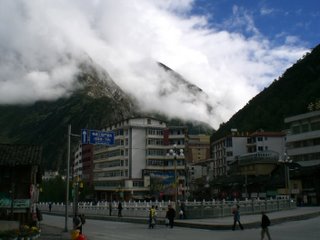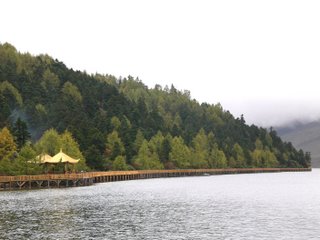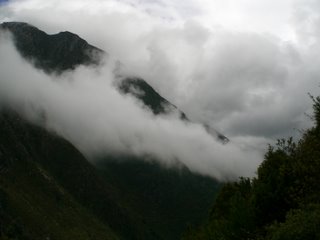The Wild West (Part Two)
 An eight hour trip became one of about nine and a half but that didn’t really matter anymore. And, in any case, the journey was so spectacular that we’d have happily stayed on the bus even longer.
An eight hour trip became one of about nine and a half but that didn’t really matter anymore. And, in any case, the journey was so spectacular that we’d have happily stayed on the bus even longer.We sped on through colossal gorges, wild gashes slashed through rock and greenery. Everything was green. Green was the only colour. But it was in a whole spectrum of shades and tones that made it seem that here were all the colours you’d ever need.
Valleys were stitched together with elegant bridges leaping across craggy voids. The narrow road switched back and back on itself again creeping higher and higher. We looked down on monumental dams plugging still lakes and furious rivers tumbling to their destinations, rope bridges spun between their banks.
 It was night when we pulled into Kangding. Rain. Pouring rain in the dark. Tired and a little disoriented we found the hostel and negotiated a price to make us feel we’d not been ripped off. We slept well.
It was night when we pulled into Kangding. Rain. Pouring rain in the dark. Tired and a little disoriented we found the hostel and negotiated a price to make us feel we’d not been ripped off. We slept well.A foaming river tears through the middle of Kangding and a procession of lamps shaped like Buddhist prayer wheels usher it from one end to the other. Lonely Planet sums the place up well: “there is a tangible sense that you’ve reached the end of the Chinese world and the beginning of the Tibetan”.
Three mountains tower above the town, one inscribed with a huge Buddhist mural on its bare rock face and each one strewn with faded prayer flags. A chill, fresh breeze reminds you you’re well away from the city now.
Sipping Nescafé first thing the next morning, our day took an interesting twist. Four Chinese tourists at the hostel said they were taking a minibus to Mugecuo Hu, one of the highest lakes in northern Sichuan, and would we like to share the cost by joining them? The decision didn’t take much making.

All squeezed together in a rackety old microbus, we headed north up the Yala Valley to Mugecuo Hu whose name literally means ‘Wild Men’s Lake’. Lonely Planet (again) warns travellers not to stray too far from the paths as it is also home to “wolves and other wild beasts”…

We arrived at a Glastonbury-like muddy field with cars skidding in the mush and middle-aged ladies negotiating puddles in high heels. Even the toilets with their open pits and holes in the floor were festivalesque.
But, after a chain of further (mini)bus rides, we escaped the crowds and reached the lake. Pure white clouds swaddled the dark peaks surrounding the lake and swooped down in the wind to the water’s surface. All along the far bank there was a wooden walkway punctuated by pavilions where you could buy yak meat on skewers. Blue skies gave way to rain but that simply made the view more spectacular still.
 The next day, we took on Paoma Shan – one of the mountains (well, it’s a great big hill) that surround Kangding for views that my photography skills probably fail to do justice to. The route begins with a wander through a lamasery where rows of prayer wheels beg to be turned to have their prayers within them spread on the wind. Through a tiny wooden doorway (curiously, with broken glass set in concrete along its lintel) we found erratic stone steps leading steeply up the hillside. Faded prayer flags marked the route as we rose higher above the town and measured ourselves against the truly impressive Gongga Shan mountain (7556m) alongside.
The next day, we took on Paoma Shan – one of the mountains (well, it’s a great big hill) that surround Kangding for views that my photography skills probably fail to do justice to. The route begins with a wander through a lamasery where rows of prayer wheels beg to be turned to have their prayers within them spread on the wind. Through a tiny wooden doorway (curiously, with broken glass set in concrete along its lintel) we found erratic stone steps leading steeply up the hillside. Faded prayer flags marked the route as we rose higher above the town and measured ourselves against the truly impressive Gongga Shan mountain (7556m) alongside. It took about an hour to ascend, quite literally, through the clouds. Mountains were all you could see in every direction. The air was fresh and the sky was blue (a revelation to any resident of Chengdu). But peace, quiet and contemplation? Forget it: building work is going on to transform the summit into some kind of Tibetan theme park.
It took about an hour to ascend, quite literally, through the clouds. Mountains were all you could see in every direction. The air was fresh and the sky was blue (a revelation to any resident of Chengdu). But peace, quiet and contemplation? Forget it: building work is going on to transform the summit into some kind of Tibetan theme park.We decided to get close to Tibetan culture in an altogether better way and came down for a good old fashioned Kangding night out…


0 Comments:
Post a Comment
Subscribe to Post Comments [Atom]
<< Home